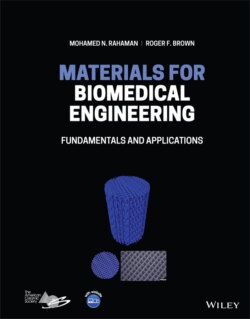Читать книгу Materials for Biomedical Engineering - Mohamed N. Rahaman - Страница 124
True Stress and Strain Versus Engineering (Nominal) Stress and Strain
ОглавлениеSpecimens of ductile metals can show a significant decrease in their cross‐sectional area during tensile testing due to a large deformation in the ductile region. Consequently, for these specimens, stress can be defined in two ways:
True stress σ, the load divided by the instantaneous cross‐sectional area of the specimen which compensates for the reduction in area
Engineering stress σn, sometimes called nominal stress, the load divided by the initial cross sectional area of the specimen which does not compensate for a change in the area.
Similar to stress, the strain can also be defined in two ways. For a specimen of length l that is deformed by an infinitesimally small value dl, the true strain ε is defined as the integral of all the infinitesimally small strains, that is
(4.18)
where, lo is the initial length of the specimen. The relation between the true strain and the engineering (nominal) strain εn is
(4.19)
The true stress σ, that is, the applied load divided by the instantaneous area, can also be found from the engineering or nominal stress σn and εn according to the equation
(4.20)
For small strains, such as strains in the elastic region of most solids but not in rubbers, a distinction between the true value of the stress and strain and their engineering (nominal) value is not relevant because their true value is almost equal to their engineering value. On the other hand, at large deformations in the ductile region, it is important to distinguish between true and engineering values for stress and strain.
